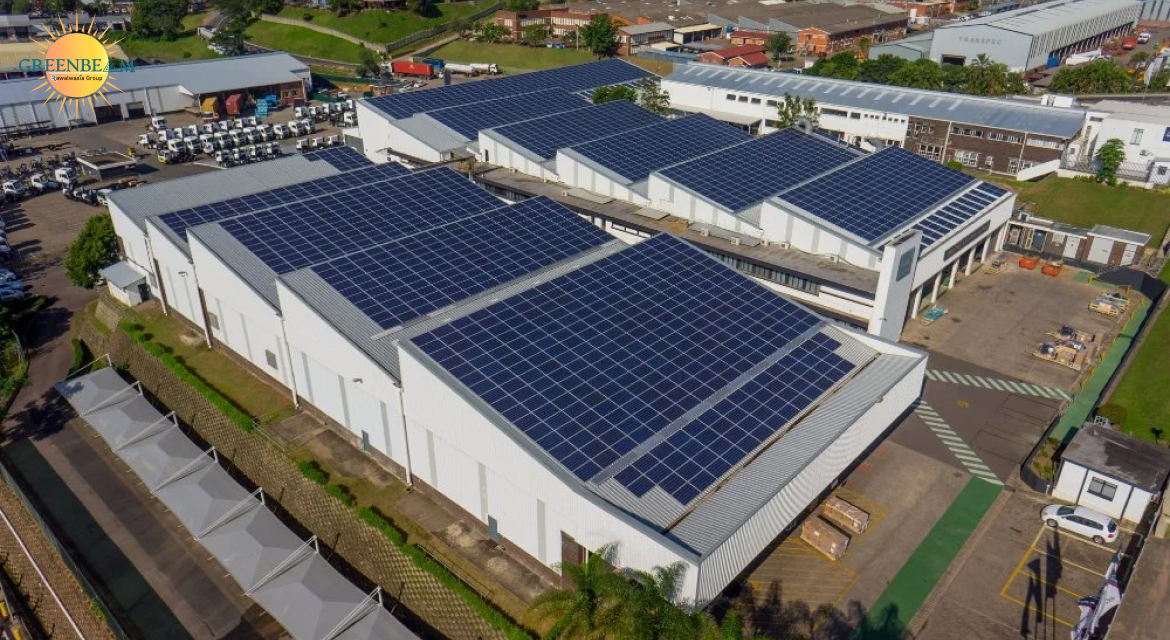As global concerns about climate change intensify and energy costs continue to rise, many homeowners and businesses turn to sustainable alternatives like rooftop solar to meet their energy needs. Greenbeam Earth Pvt. Ltd., part of the Rawalwasia Group, is at the forefront of this revolution, making clean, renewable energy accessible across Gujarat. Our mission is to power homes and businesses and contribute to a greener planet, helping reduce India’s carbon footprint through innovative solar energy solutions.
What Is Rooftop Solar?
Rooftop solar refers to the solar panels installed on the roofs of residential, commercial, or industrial buildings. These panels harness sunlight and convert it into electricity through photovoltaic (PV) cells. The electricity generated can be used immediately, stored in batteries, or fed back into the grid, reducing reliance on traditional power sources.
Greenbeam is actively developing solar parks and rooftop solar projects across Gujarat, focusing on providing clean, renewable energy to local communities and businesses. Our 100 MW project, spanning 8 locations, is designed to help reduce carbon emissions and provide affordable, reliable power to our customers.
Why Choose Rooftop Solar?
The decision to switch to rooftop solar offers numerous benefits for individuals and businesses. Here’s why you should consider it:
- Cost Savings: One of the most significant advantages of rooftop solar is the potential to save on electricity bills. Generating your own power can reduce or even eliminate your reliance on the grid.
- Environmental Impact: Solar energy is a clean, renewable resource. By switching to solar, you’re helping combat climate change by reducing harmful greenhouse gas emissions.
- Energy Independence: Rooftop solar allows you to generate electricity, making you less dependent on traditional energy sources and more resilient to power outages.
How Rooftop Solar Works
Rooftop solar systems comprise solar panels, inverters, and, in some cases, batteries for energy storage. Here’s how they work:
- Solar Panels: The solar panels’ Photovoltaic (PV) cells absorb sunlight and convert it into direct current (DC) electricity.
- Inverter: DC electricity is sent to an inverter, which converts it into alternating current (AC) electricity that can power your home or business.
- Energy Consumption: The electricity generated is used directly to power appliances and lighting. Depending on your setup, any excess energy can be stored in batteries or sent back to the grid.
- Grid Connection: In most cases, rooftop solar systems are connected to the grid. If your system produces more energy than you need, it can be fed back into the grid, earning you credits or payments through a process known as net metering.
Greenbeam is working closely with DISCOMs to ensure a seamless integration between rooftop solar systems and the grid, allowing our customers to maximise their energy savings.
Advantages of Rooftop Solar for Businesses
For businesses, rooftop solar is not just a way to reduce operational costs; it’s a powerful tool for enhancing brand reputation and demonstrating a commitment to sustainability.
- Cost-Effective Energy: Businesses consume large amounts of energy, and rooftop solar can significantly lower electricity costs, freeing up capital for other operational needs.
- Corporate Social Responsibility (CSR): Adopting solar energy reflects positively on a company’s CSR efforts, showcasing your commitment to environmental stewardship.
- Energy Security: Businesses that generate their electricity are less vulnerable to fluctuations in energy prices and can avoid costly disruptions caused by power outages.
At Greenbeam, we provide tailored rooftop solar solutions for businesses, ensuring that our systems meet your energy needs and budget.
Government Policies Supporting Rooftop Solar in India
India’s government has set ambitious targets to increase the adoption of solar energy, with rooftop solar being a critical component of this strategy. Policies such as the Jawaharlal Nehru National Solar Mission (JNNSM) have helped boost solar installations nationwide.
The following are some key government initiatives that support the installation of rooftop solar:
- Subsidies: The Ministry of New and Renewable Energy (MNRE) offers financial subsidies for rooftop solar systems, helping reduce the initial investment.
- Net Metering: Through net metering policies, consumers can earn credits or payments for the excess energy they send back to the grid.
- Priority Lending: Banks and financial institutions provide priority lending for solar installations, making financing your rooftop solar project easier.
Greenbeam works closely with government bodies and DISCOMs to ensure our customers benefit from all available incentives and policies and maximise their return on investment.
Installation Process of Rooftop Solar
Installing rooftop solar with Greenbeam is a straightforward process, with our team handling every aspect of the project, from site assessment to system installation and maintenance. Here’s a brief overview of the installation process:
- Site Assessment: Our team thoroughly assesses your roof to determine its suitability for solar panels. Factors like roof space, orientation, and shading are evaluated to ensure optimal performance.
- System Design: We design a customised solar solution tailored to your energy needs and budget based on the assessment.
- Installation: Once the design is finalised, our experienced technicians install the solar panels and related components on your roof.
- Connection to Grid: After installation, we connect the system to the grid and ensure everything functions smoothly.
- Ongoing Maintenance: Greenbeam offers ongoing monitoring and maintenance services to ensure your solar system continues operating at peak efficiency.
The Role of Rooftop Solar in India’s Renewable Energy Future
As one of the fastest-growing economies in the world, India faces the challenge of meeting its growing energy needs while reducing its carbon footprint. Solar energy, particularly rooftop solar, is crucial in transitioning to a more sustainable energy future.
India’s solar capacity has grown exponentially over the past decade, driven by government policies, technological advancements, and increased awareness of the benefits of renewable energy. Rooftop solar, in particular, has emerged as a key solution for urban areas where land availability for large-scale solar farms is limited.
Greenbeam is proud to contribute to India’s renewable energy future through our rooftop solar and solar park projects. Our ongoing development of a 100+ MW solar park near Kosamba will help meet the growing demand for clean energy while supporting local communities and reducing the country’s dependence on fossil fuels.
Greenbeam’s Commitment to Sustainability
At Greenbeam, sustainability is at the heart of everything we do. Our goal is to provide innovative solar solutions that meet our customer’s energy needs and help protect the environment for future generations.
We are working to create a cleaner, greener future for India through our rooftop solar projects and solar parks. By generating renewable energy, we reduce carbon emissions, support local economies, and contribute to the global fight against climate change.
Frequently Asked Questions
What is the lifespan of a rooftop solar system?
Ans: A typical rooftop solar system can last 25 to 30 years with proper maintenance. Solar panels are durable and designed to withstand various weather conditions, making them a long-term investment.
Can I store excess energy from my rooftop solar system?
Ans: Yes, you can store excess energy using battery storage systems. Alternatively, with a grid-tied system, you can return excess power to the grid and receive credits or payments through net metering.
What is net metering?
Ans: Net metering is a billing mechanism that allows you to earn credits or payments for the excess electricity your rooftop solar system generates and sends back to the grid.
Can rooftop solar work on cloudy or rainy days?
Ans: Yes, solar panels can still generate electricity on cloudy or rainy days, although the efficiency may be reduced. Most systems are designed to work efficiently even in less-than-ideal weather conditions.






